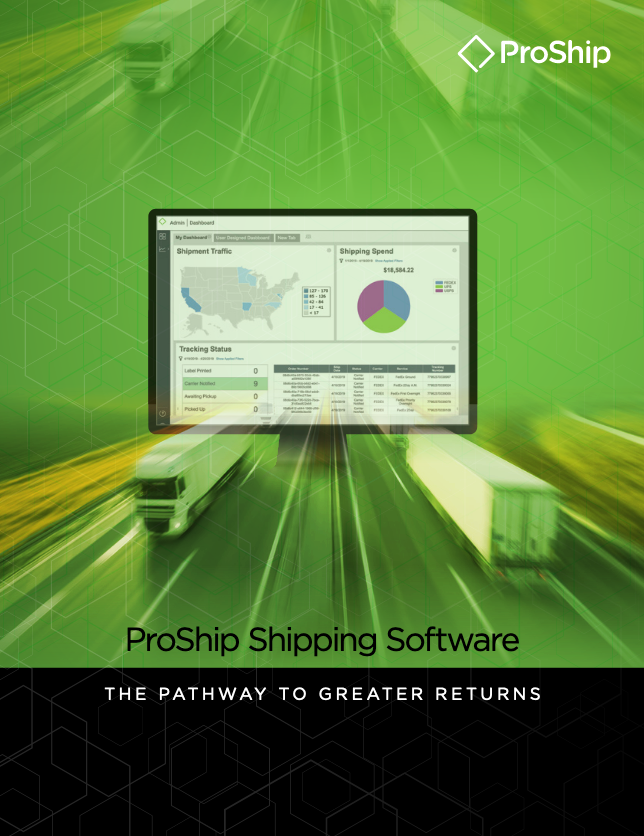Confirm your parcel shipping strategy is as solid as can be come peak season
No time of the year is more critical and stressful for shippers than the holiday peak season, and in a global pandemic, things have never been more nerve-wracking. But as you hunker down and start focusing on your peak strategy, make sure you’re taking a good long look at your parcel shipping operation. What didn’t work in past years? What did you want to change but haven’t gotten to yet? Some of these things are easy to spot, but others might not be in plain sight, or you may not fully understand why you’re struggling with them.
Our experts at ProShip have put together a top 10 list of parcel shipping mistakes you may currently be making. Here in part one we will talk about the first five. [Part 2]
1. Shipping with a Single-Carrier Approach
Though utilizing a single carrier for all your parcel shipping needs may sound like an easy way to go, there are actually serious risks to this strategy. Thanks in part to the rise in technology, e-commerce and mobile shopping have grown exponentially making shipping the backbone of the customer experience and putting major pressure on carrier delivery networks.
While carriers have tried to keep up with the demand by investing their efforts into improving their networks by adding facilities, automation, technology and people, it still does not guarantee that a carrier will not be overloaded on a particular lane for a few days. And that risk only increases with pandemics, bad weather and peak holiday shipping times.
However, one of the biggest risks seen by using a single carrier for any level of service is the lack of choice – the choice to make a better shipment execution decision. A decision like this can meet/exceed your customer’s expectations at an acceptable price, or it can be the decision no shipper wants to make (meet expectations at a high price or go with a low price that will not meet the expectation). Using only one carrier gives you only one zone map for your shipping software to look at. By using two or more carriers, customers can be provided with more options, and shippers can execute on them at the lowest cost possible.
FIX: Onboard more carriers! Easier said than done, right? Without the right technology, adding a single carrier at a time may be extremely time-consuming, plus you would have to switch between interfaces to compare routes and rates. This is an extremely slow process, and the dollars and time wasted is not worth it. With the right multi-carrier shipping software, you can quickly onboard multiple carriers and rate shopping services as you see fit, giving you access to easy alternatives if a carrier lane goes down due to technical, physical or contractual reasons.
2. Choosing Carrier APIs over Certified Engines
Parcel carriers offer free online APIs that can be used to obtain shipping rates, print shipping labels and provide manifest information. The temptation for developers to leverage this free technology from the carriers is strong. In creating a multi-carrier shipping solution, many choose to simply aggregate carrier APIs together, creating a system that, while functional, leaves performance on the roadside. If you’re using this strategy during peak, you may run into issues such as…
- Flexibility: With APIs, you’re getting basic carrier connectivity only (rate and label only), which means your unique business logic and extra complexity falls onto your business to set up.
- Resources: Smaller solution means smaller teams who outsource developers and support teams. Experiencing slow speeds or even downtime during peak? Support may take longer than expected to respond and fix any issues.
- Compliance: It’s your software provider’s responsibility to keep you compliant at all times. Non-compliance can cause chargebacks and fees that add up quickly, and only full-service solutions have the ability to dedicate a full development team towards compliance initiatives.
- Scalability: With these smaller API-only solutions, there are throughput limits, and the solution often gets strained. Due to these constraints, during peak season and as you grow, you’ll realize the need to re-invest in a new solution that scales with your growth and provides up-and-coming omnichannel features as needed.
FIX: Go with a shipping technology that builds parcel compliance engines from the ground up in accordance with carrier specifications. The result can be a powerful parcel engine that, when installed into your shipping operation, gives you multiple benefits such as high performance, increased reliability, extended carrier portfolio, expanded solution capabilities and topline support. [Dive deeper into this topic]
3. Using a Transportation Management System (TMS)

TMS software was developed for planning freight movement and freight rating, load planning, inbound shipping and a laundry list of other features. Many times, companies believe a TMS is the answer to their parcel shipping problems, but with e-commerce orders rising through the roof, TMS-only shipping houses may be in a world of hurt. Why? Because a TMS is overkill for parcel. The primary capabilities of a TMS may work well for freight shipping, but they are often too broad to handle the finer nuances of parcel shipping. It’s a big investment and could be a major mistake if your main focus is creating an efficient and cost-effective parcel shipping strategy.
FIX: Enter multicarrier shipping software, a platform designed for high volume parcel shipping (think of it as a TMS built specifically for small parcel). This unique solution can be used on its own or integrates with a TMS to create a full shipping strategy – from freight to small parcels. In addition to offering multiple shipping methods, multi-carrier shipping software also offers a variety of benefits for companies shipping parcel such as increased sales, expanded carrier portfolio, boosted customer experience and an increased feature set like omnichannel fulfillment. [Dive deeper into this topic]
4. Managing a Home-Grown Solution
Some companies choose the route of creating and maintaining a homegrown shipping solution that may include carrier systems as the main technology. This is typically for shippers who have enough technical resources to build and manage the solution and who want to keep costs down by utilizing free carrier systems provided within their contracts (UPS/FedEx/Etc).
The number one pain point of managing a homegrown solution? Resource limitations. Multi-carrier shipping is a beast to maintain. Many companies run into the inability to support the solution or lack the functionality to expand on their current strategy as needed. If you’re utilizing a homegrown solution, you may be struggling with…
- Adding new carriers
- Compliance and certifications
- Turnover (employees who create and support the solution leave or retire, leaving remaining colleagues with the work)
- Using time and resources to support the solution
FIX: Let the experts take this off your plate. Yes, the carriers provide a very useful service with their free carrier systems. They are vital for specific functions like tracking, or when they are the carrier’s preferred way to ensure compliance to their specifications. They deliver on what they were designed to be – a low-cost means to connect lower-volume shippers with unsophisticated requirements to carrier services. But before you consider keeping this in-house, consider your business’ destination and make sure you’re equipped with the resources that will take you there. Shippers now have more options for multi-day, next day, even same day delivery than ever before, and customer expectations are rising accordingly. New technologies are emerging that will revolutionize parcel shipping and the customer experience from cart to delivery.
5. Shrugging Off Support Woes
If you’re compromising on support during regular shipping times, imagine how you’ll feel come peak season. A shipping software vendor is only as good as the product it supports. When it comes to IT systems, things can go wrong, but you want to make sure your vendor is continuously doing everything possible to ensure that doesn’t happen. The people and the company providing your business-critical software solutions need to be invested in your success and committed to the relationship. Ask yourself: What would it cost my company if our parcel shipping functionality went down for a few hours? A day? Multiple days?
FIX: The best support responds within the hour and isn’t outsourced. It’s in-house software and logistics experts with access to a dedicated account manager and service engineering team. Dig deep and understand your vendor’s support team/plan and how quickly they’ve promised response times within your contract. Have they held up their end of the bargain, or have they thrown empty promises at you? Compare SLA times and other support features to other vendors if you’re not feeling the love.
It’s extremely important to understand what is needed to improve process quality and performance before the hustle and bustle of the peak holiday season. We highly recommend doing a re-evaluation of your current shipping software vendor, carrier mix and processes.
Next week we’ll be going over Part 2, which touches on automation, shipping data, address validation, sunsetting products and custom labels. [Read Part 2]
ProShip content you might also like…

 Back to Blog
Back to Blog





